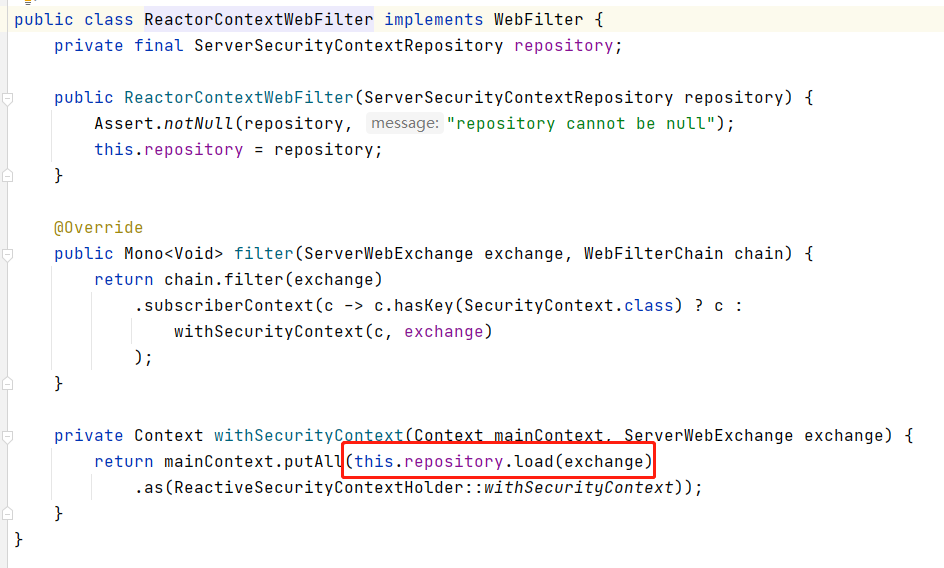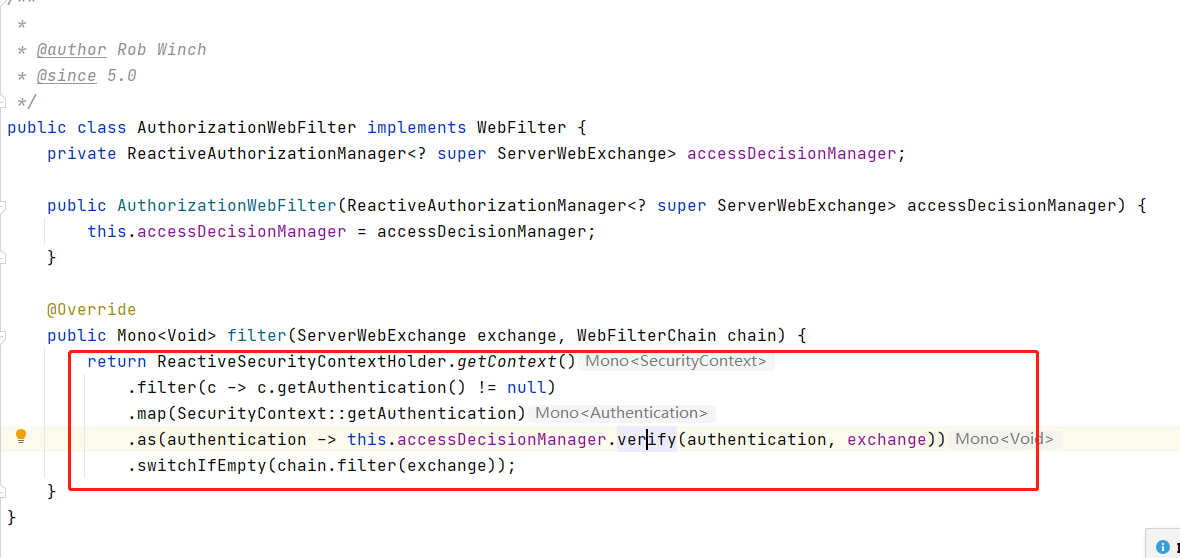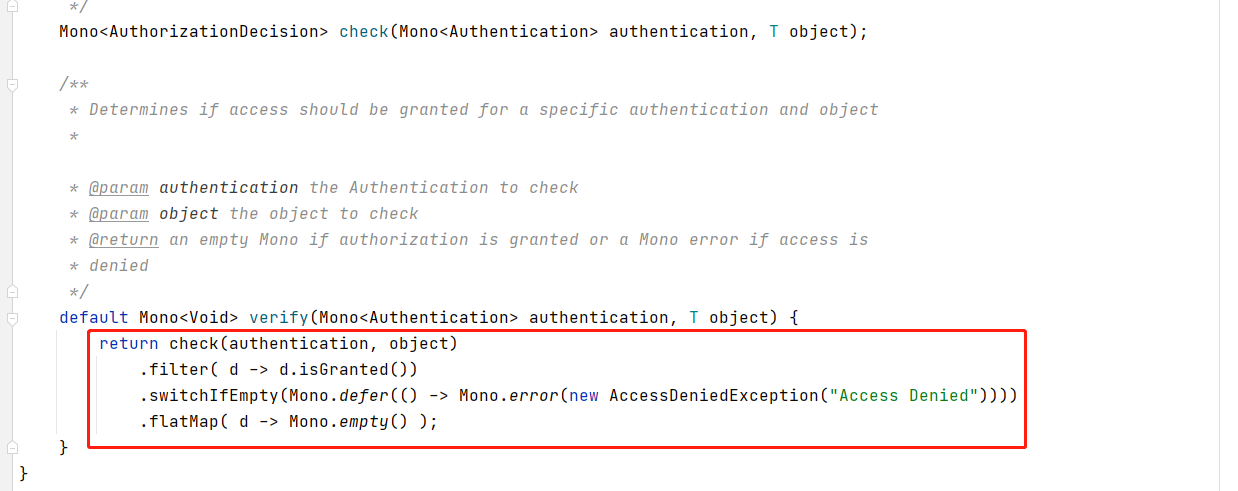Spring-Gateway与Spring-Security在前后端分离项目中的实践
前言
网上貌似webflux这一套的SpringSecurity操作资料貌似很少。
自己研究了一波,记录下来做一点备忘,如果能帮到也在迷惑的人一点点,就更好了。
新项目是前后端分离的项目,前台vue,后端SpringCloud2.0,采用oauth2.0机制来获得用户,权限框架用的gateway。
一,前台登录
大概思路前台主要是配合项目中配置的clientId,clientSecret去第三方服务器拿授权码code,然后拿这个code去后端交互,后端根据code去第三方拿用户信息,由于第三方只保存用户信息,不管具体的业务权限,所以我会在本地保存一份用户副本,用来做权限关联。用户登录成功后,会把一些用户基本信息(脱敏)生成jwt返回给前端放到head中当Authorization,同时后端把一些相关联的菜单,权限等数据放到redis里做关联,为后面的权限控制做准备。
二,SpringSecurity的webflux应用
如果用过SpringSecurity,HttpSecurity应该是比较熟悉的,基于Web允许为特定的http请求配置安全性。
WebFlux中ServerHttpSecurity与HttpSecurity提供的相似的类似,但仅适用于WebFlux。默认情况下,它将应用于所有请求,但可以使用securityMatcher(ServerWebExchangeMatcher)或其他类似方法进行限制。
项目比较特殊,就不能全展示了,大概写一写,开启Security如下:
@EnableWebFluxSecurity
public class MyExplicitSecurityConfiguration {
@Bean
SecurityWebFilterChain webFluxSecurityFilterChain(ServerHttpSecurity http) throws Exception {
http.securityContextRepository(new NoOpServerSecurityContextAutoRepository(tokenProvider)).httpBasic().disable()
.formLogin().disable()
.csrf().disable()
.logout().disable();
http.addFilterAt(corsFilter(), SecurityWebFiltersOrder.CORS)
.authorizeExchange()
.matchers(EndpointRequest.to("health", "info"))
.permitAll()
.and()
.authorizeExchange()
.pathMatchers(HttpMethod.OPTIONS)
.permitAll()
.and()
.authorizeExchange()
.pathMatchers(HttpMethod.PUT)
.denyAll()
.and()
.authorizeExchange()
.pathMatchers(HttpMethod.DELETE)
.denyAll()
.and()
.authorizeExchange()
.pathMatchers(HttpMethod.HEAD)
.denyAll()
.and()
.authorizeExchange()
.pathMatchers(HttpMethod.PATCH)
.denyAll()
.and()
.authorizeExchange()
.pathMatchers(HttpMethod.TRACE)
.denyAll()
.and()
.authorizeExchange()
.pathMatchers(excludedAuthPages).permitAll()
.and()
.authorizeExchange()
.pathMatchers(authenticatedPages).authenticated()
.and()
.exceptionHandling()
.accessDeniedHandler(new AccessDeniedEntryPointd())
.and()
.authorizeExchange()
.and()
.addFilterAt(webFilter(), SecurityWebFiltersOrder.AUTHORIZATION)
.authorizeExchange()
.pathMatchers("/**").access(new JwtAuthorizationManager(tokenProvider))
.anyExchange().authenticated();
return http.build();
}
}
因为是前后端分离项目,所以没有常规的后端的登录操作,把这些disable掉。
securityContextRepository是个用于在请求之间保留SecurityContext策略接口,实现类是WebSessionServerSecurityContextRepository(session存储),还有就是NoOpServerSecurityContextRepository(用于无状态应用),像我们JWT这种就用后者,不能用前者,应该我们是无状态的应用,没有主动clear的操作,会导致内存溢出等问题。
build()方法中会有一个初始化操作。

初始化操作就设置成了WebSessionServerSecurityContextRepository,我们就自己在SecurityWebFilterChain中设置成NoOpServerSecurityContextRepository。
接下来我们为了满足自定义认证需求,我们自己配置一个AuthenticationWebFilter。
public AuthenticationWebFilter webFilter() {
AuthenticationWebFilter authenticationWebFilter = new AuthenticationWebFilter(new JWTReactiveAuthenticationManager(userCache, tokenProvider, coreUserApi));
authenticationWebFilter.setServerAuthenticationConverter(new TokenAuthenticationConverter(guestList, tokenProvider));
authenticationWebFilter.setRequiresAuthenticationMatcher(new NegatedServerWebExchangeMatcher(ServerWebExchangeMatchers.pathMatchers(excludedAuthPages)));
authenticationWebFilter.setSecurityContextRepository(new NoOpServerSecurityContextAutoRepository(tokenProvider));
return authenticationWebFilter;
}
几个特殊的类,稍微解释下。
AuthenticationWebFilter
一个执行特定请求身份验证的WebFilter,包含了一整套验证的流程操作,具体上源码看一眼基本能了解个大概。
@Override
public Mono<Void> filter(ServerWebExchange exchange, WebFilterChain chain) {
return this.requiresAuthenticationMatcher.matches(exchange)
.filter( matchResult -> matchResult.isMatch())
.flatMap( matchResult -> this.authenticationConverter.convert(exchange))
.switchIfEmpty(chain.filter(exchange).then(Mono.empty()))
.flatMap( token -> authenticate(exchange, chain, token))
.onErrorResume(AuthenticationException.class, e -> this.authenticationFailureHandler
.onAuthenticationFailure(new WebFilterExchange(exchange, chain), e));
}
private Mono<Void> authenticate(ServerWebExchange exchange, WebFilterChain chain, Authentication token) {
return this.authenticationManagerResolver.resolve(exchange)
.flatMap(authenticationManager -> authenticationManager.authenticate(token))
.switchIfEmpty(Mono.defer(() -> Mono.error(new IllegalStateException("No provider found for " + token.getClass()))))
.flatMap(authentication -> onAuthenticationSuccess(authentication, new WebFilterExchange(exchange, chain)));
}
protected Mono<Void> onAuthenticationSuccess(Authentication authentication, WebFilterExchange webFilterExchange) {
ServerWebExchange exchange = webFilterExchange.getExchange();
SecurityContextImpl securityContext = new SecurityContextImpl();
securityContext.setAuthentication(authentication);
return this.securityContextRepository.save(exchange, securityContext)
.then(this.authenticationSuccessHandler
.onAuthenticationSuccess(webFilterExchange, authentication))
.subscriberContext(ReactiveSecurityContextHolder.withSecurityContext(Mono.just(securityContext)));
}

ServerWebExchangeMatcher
一个用来匹配URL用来验证的接口,我代码中用的是他的实现类NegatedServerWebExchangeMatcher,这个类就是指一些我设置的白名单的url就不要验证了,他还有许多实现类,具体可以参见源码,我这就不累述了。
ServerAuthenticationConverter
一个用于从ServerWebExchange转换为用于通过提供的org.springframework.security.authentication.ReactiveAuthenticationManager进行身份验证的Authentication的策略。 如果结果为Mono.empty() ,则表明不进行任何身份验证尝试。我这边自己实现了一个TokenAuthenticationConverter,主要功能就是通过JWT转换成Authentication(UsernamePasswordAuthenticationToken)。
ReactiveAuthenticationManager
对提供的Authentication进行身份验证,基本上核心的验证操作就在它提供的唯一方法authenticate里进行操作,根据conver那边转换过来的Authentication当参数进行具体的验证操作,简述如下:
@Override
public Mono<Authentication> authenticate(final Authentication authentication) {
if (authentication.isAuthenticated()) {
return Mono.just(authentication);
}
return Mono.just(authentication)
.switchIfEmpty(Mono.defer(this::raiseBadCredentials))
.cast(UsernamePasswordAuthenticationToken.class)
.flatMap(this::authenticateToken)
.publishOn(Schedulers.parallel())
.onErrorResume(e -> raiseBadCredentials())
.switchIfEmpty(Mono.defer(this::raiseBadCredentials))
.map(u -> {
UsernamePasswordAuthenticationToken usernamePasswordAuthenticationToken = new UsernamePasswordAuthenticationToken(authentication.getPrincipal(), authentication.getName(), Collections.EMPTY_LIST);
usernamePasswordAuthenticationToken.setDetails(u);
return usernamePasswordAuthenticationToken;
});
}
ServerSecurityContextRepository
用于在请求之间保留SecurityContext,因为在登录成功后我们是需要保存一个登录的数据,用来后面的请求进行相关的操作。因为我们是无状态的,所以其实NoOpServerSecurityContextRepository是能
满足我们的需求,我们不需要进行实际的save,但是load我们稍微要改造下,所以我实现了ServerSecurityContextRepository,仿照NoOpServerSecurityContextRepository,实现了一个自定义的Repository,为什么load我们要改造,就是因为虽然我们是无状态的,但是实际上每次请求,我们依然要区分到底是谁,为了后面的权限验证做准备,所以我们根据jwt可以生成一个SecurityContext放入ReactiveSecurityContextHolder。


public class NoOpServerSecurityContextAutoRepository
implements ServerSecurityContextRepository {
private TokenProvider tokenProvider;
public NoOpServerSecurityContextAutoRepository(TokenProvider tokenProvider) {
this.tokenProvider = tokenProvider;
}
public Mono<Void> save(ServerWebExchange exchange, SecurityContext context) {
return Mono.empty();
}
public Mono<SecurityContext> load(ServerWebExchange exchange) {
String token = exchange.getRequest().getHeaders().getFirst("Authorization");
if (StrUtil.isNotBlank(token)) {
SecurityContext securityContext = new SecurityContextImpl();
securityContext.setAuthentication(new UsernamePasswordAuthenticationToken("password", token, Collections.EMPTY_LIST));
return Mono.justOrEmpty(securityContext);
} else {
return Mono.empty();
}
}
}
权限验证

权限验证是在图上配置的。大概的流程,可以看下面的截图。


AuthorizationWebFilter
跟到里面,我们发现了最主要的就是这个AuthorizationWebFilter,用来做权限验证的,然后我们在filter方法里面就看得很清楚了,他第一步就是拿的ReactiveSecurityContextHolder.getContext(),然后我们之前在ReactorContextWebFilter里的load操作就是从我们NoOpServerSecurityContextAutoRepository里塞到ReactiveSecurityContextHolder里,因为本质 来说SpringSecurity就是个filter集合,我们从ReactorContextWebFilter里load,然后在AuthorizationWebFilter取,这样就能拿到Authentication来做权限验证了。

ReactiveAuthorizationManager
反应式授权管理器接口,可以确定Authentication是否有权访问特定对象。其实看源码就很清楚了,就是根据Authentication来做具体的权限验证。

代码很清楚,就不细讲了,我们主要是写check方法。所以我这边自已实现了一个JwtAuthorizationManager类用来做具体的check,内容我就不贴了,简单来说就是拿Authentication里的内容去redis里查对应的菜单权限。
结语
上面就我实际项目中的一些点滴记录,Spring-Security虽是一个博大精深的框架,细研究代码,其实也能大致明白整体的思路,虽然webflux让这一层代码更加了一层迷雾,但是只要努力钻研,总会有茅塞顿开的时候。
附上相关代码,由于是生产项目,只能截取部分代码,仅供参考。
Spring-Gateway与Spring-Security在前后端分离项目中的实践的更多相关文章
- 《论vue在前后端分离项目中的实践之年终总结》
我是2014年的时候开始了解知道的vue,当时vue还不太成熟,想用但是又怕自己hold不住,况且那时候vue还没有成熟的(路由.验证.ui组件)插件,社区也是不温不火的,再说也没有合适的机遇让我去项 ...
- 分享我在前后端分离项目中Gitlab-CI的经验
长话短说,今天分享我为前后端分离项目搭建Gitlab CI/CD流程的一些额外经验. Before Gitlab-ci是Gitlab提供的CI/CD特性,结合Gitlab简单友好的配置界面,能愉悦的在 ...
- 基于spring security 实现前后端分离项目权限控制
前后端分离的项目,前端有菜单(menu),后端有API(backendApi),一个menu对应的页面有N个API接口来支持,本文介绍如何基于spring security实现前后端的同步权限控制. ...
- 在前后端分离项目中使用SpringBoot集成Shiro
前言 这次在处理一个小项目时用到了前后端分离,服务端使用springboot2.x.权限验证使用了Shiro.前后端分离首先需要解决的是跨域问题,POST接口跨域时会预发送一个OPTIONS请求,浏览 ...
- 前后端分离项目中后台集成shiro需要注意的二三事
1. 修改 Shiro 认证失败后默认重定向处理问题 a. 继承需要使用的 ShiroFilter,重载 onAccessDenied() 方法: @Override protected boolea ...
- 前后端分离项目 nginx配置实践
新项目采用前后端分离的方式开发,前后端代码打算分开部署(同机器且同域名),但打算支持后端依然可访问静态资源. 搜索nginx配置大部分都通过url前缀进行转发来做前后端分离,不适用目前项目. 说明 前 ...
- 08 Django REST Framework 解决前后端分离项目中的跨域问题
01-安装模块 pip install django-cors-headers 02-添加到INSTALL_APPS中 INSTALLED_APPS = ( ... 'corsheaders', .. ...
- Aspnet Mvc 前后端分离项目手记(二)关于token认证
在前后端分离的项目中,首先我们要解决的问题就是身份认证 以往的时候,我们使用cookie+session,或者只用cookie来保持会话. 一,先来复习一下cookie和session 首先我们来复习 ...
- 实战!spring Boot security+JWT 前后端分离架构认证登录!
大家好,我是不才陈某~ 认证.授权是实战项目中必不可少的部分,而Spring Security则将作为首选安全组件,因此陈某新开了 <Spring Security 进阶> 这个专栏,写一 ...
随机推荐
- vue项目配置 `webpack-obfuscator` 进行代码加密混淆
背景 公司代码提供给第三方使用,为了不完全泄露源码,需要对给出的代码进行加密混淆,前端代码虽然无法做到完全加密混淆,但是通过使用 webpack-obfuscator 通过增加随机废代码段.字符编码转 ...
- WPF -- 构建动画
写在前面:本文代码摘自<Head First C#> 本文使用ObjectAnimationUsingKeyFrames + Storyboard构建一个动画. ObjectAnimati ...
- web前端学习笔记(二)---Django
[前言]前面(一)学习了web的基础知识,介绍到了MVC,项目使用一个Django框架. Django book:https://code.ziqiangxuetang.com/django/djan ...
- 使用Prometheus搞定微服务监控
最近对服务进行监控,而当前监控最流行的数据库就是 Prometheus,同时 go-zero 默认接入也是这款数据库.今天就对 go-zero 是如何接入 Prometheus ,以及开发者如何自己定 ...
- 代理模式详解:静态代理、JDK动态代理与Cglib动态代理
代理模式简介分类 概念 代理,是为了在不修改目标对象的基础上,增强目标方法的业务逻辑. 客户类需要执行的是目标对象的目标方法,但是真正执行的是代理对象的代理方法,客户类对目标对象的访问是通过代 ...
- Prometheus自定义指标
1. 自定义指标 为了注册自定义指标,请将MeterRegistry注入到组件中,例如: public class Dictionary { private final List<String ...
- SpringBoot自动配置原理源码级别分析
SpringBoot自动配置原理 前言 后面还会讲到SpringBoot自动配置原理,会主要讲解@EnableAutoConfiguratuon注解帮助我们做了什么事情,是如何自动把自动配置类扫描到容 ...
- Memory Networks01 记忆网络经典论文
目录 1.Memory Networks 框架 流程 损失函数 QA 问题 一些扩展 小结 2.End-To-End Memory Networks Single Layer 输入模块 算法流程 Mu ...
- 【odoo14】第十八章、自动化测试
当我们开发大型应用的时候,通过自动化测试可以大幅提高应用的健壮性.每年,odoo都会发布新版本,自动化测试对于应用的回归测试非常有帮助.幸运的是,odoo框架有不同自动化测试用例.odoo主要包括三种 ...
- python基础学习之描述符和装饰器
描述符的了解: 描述符协议: python描述符是一个"绑定行为"的对象属性,在描述符协议中,它可以通过方法重写属性的访问.这些方法有: __get__, __set__, 和__ ...
